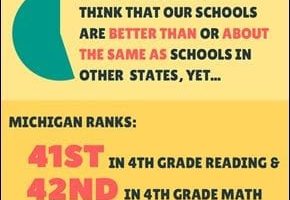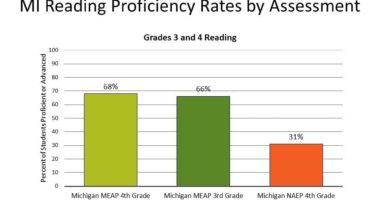Honest Information on School Performance: Michigan Needs Clarity in Measuring Quality
New state school accountability system provides important data, but needs improvement to better serve educators, families
ROYAL OAK, MICH. (August 20, 2013) – Today the Michigan Department of Education released its results from the new state-wide school accountability and public reporting system, now being implemented for the first time. While the new system provides important information on school performance, it lacks the clear, coherent information that parents need and educators deserve to improve their schools’ performance.
The MDE’s new system is a dramatic improvement over the state’s previous school public reporting system, which had graded almost all schools as high performers- even while Michigan’s relative educational performance was declining for years. However, it also sends mixed messages about individual school performance in Michigan. For example, some of Michigan’s highest performing schools for overall student performance received a “red” rating – or the lowest grade on the state’s new color-coded grading system. Another example: some schools received the highest grade, or a green rating, even though they have no performance data yet on which to grade them accurately.
“We’re glad to see the new system being implemented, but it’s clear that we need to make further improvements to make it really user-friendly for parents and provide greater differentiation,” said Amber Arellano, executive director of The Education Trust – Midwest, a non-partisan research and advocacy organization that works for the high achievement of all Michigan students. “We need a coherent school public reporting and accountability system with A to F school grades.”
Unlike some leading states, Michigan’s school accountability and public reporting systems are not aligned – which may lead to confusing messages and consequences for educators when their schools do not perform well – due to the MDE’s grading approach.
One component of today’s release is a percentile ranking of public schools called the Top to Bottom ranking, which the state has produced for several years. It incorporates data on student achievement, achievement gaps between high and low performers, student improvement and, for high schools, graduation rates. This high-stakes ranking is used for state accountability purposes.
The second component is a school performance scorecard. The five-color scorecard awards an overall color based on the number of goals a school met, with green as the best rating and lime, yellow, orange, and red color ratings for other schools. The performance scorecard is used for public reporting purposes and to help schools identify which subjects and students need the most support. This information is essential for understanding how schools are performing for all their students, including their low-income students and students of color.
The two components are not aligned, however – and therein lies the potential for serious problems for parents who are looking for coherent, accessible information about schools in Michigan. The color-coded system provides very different information than the Top to Bottom ranking, which means that parents may be confused about whether or not their schools are performing well. Some schools, such as Discovery Arts and Technology Public School Academy, are ranked very low on Top to Bottom but have a mediocre “yellow” color on their scorecards. Other schools have the opposite problem – they have a high percentile ranking but are rated red, such as Grosse Pointe South High School.
In addition, no school was rated “lime” and many brand new schools were given color ratings even though they did not have enough assessment data to determine if they met state goals. Such incoherence may be confusing to parents, who are looking to the state to provide honest, helpful information about where to send their children to school.
The Education Trust – Midwest has long recommended the state create an A to F school grading system that is coherent and aligned with school accountability. Ed Trust – Midwest recommends any new legislation combines the Top to Bottom ranking and scorecard measures into one overall school grade. Any new school grading system would need protections against gaming, including transparency about the methodology; publically available data so others can replicate the results; and clarity about what the grading system says about school performance.
“If the state provides a single letter grade for every school in the state, parents will have a clearer picture of school performance,” said Arellano. “With a letter grade, they can get a sense of whether a school is meeting its performance goals and how it compares to schools around the state and region. Arming parents with this information is crucial when there are so many options, and so many of them are low quality.”
The Education Trust-Midwest is Michigan’s only data-driven, non-partisan state-wide research and advocacy organization focused on what is best for Michigan students. Our mission is to work for the high achievement of all students, particularly low-income, African-American, Latino and American-Indian students in Michigan, and to provide honest, reliable information and expertise to our state’s families and policymakers.
www.edtrustmidwest.org
###




